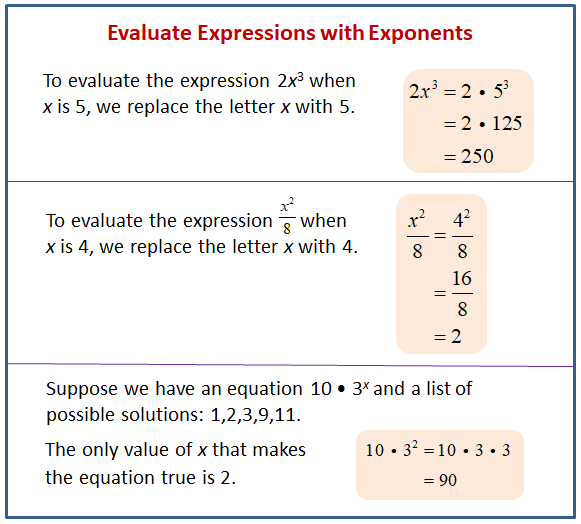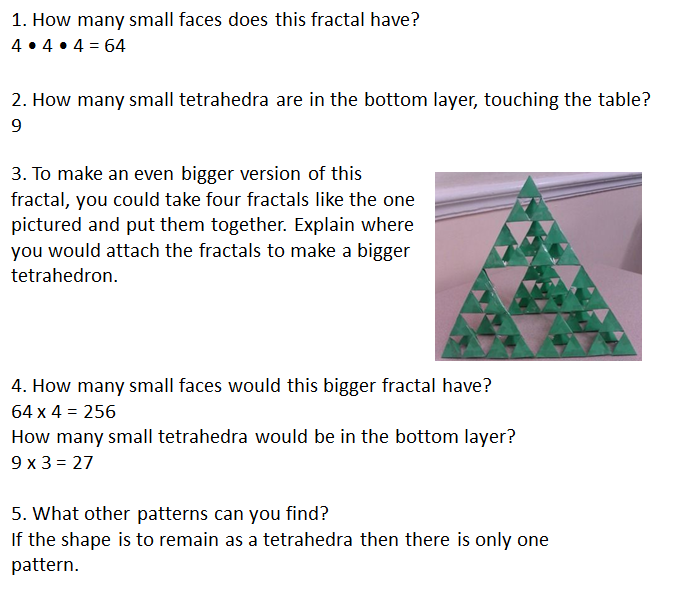Illustrative Mathematics Unit 6.6, Lesson 15: Equivalent Exponential Expressions
Learning Targets:
- I can find solutions to equations with exponents in a list of numbers.
- I can replace a variable with a number in an expression with exponents and operations and use the correct order to evaluate the expression.
Related Pages
Illustrative Math
Grade 6
Lesson 15: Equivalent Exponential Expressions
Let’s investigate expressions with variables and exponents.
Illustrative Math Unit 6.6, Lesson 15 (printable worksheets)
Lesson 15 Summary
In this lesson, we saw expressions that used the letter x as a variable. We evaluated these expressions for different values of x.
The following diagram gives some examples of evaluating expressions with exponents by substituting values for x.

Lesson 15.1 Up or Down?
- Find the values of 3x and (⅓)x for different values of x.
| x | 3x | (⅓)x |
| 1 | ||
| 2 | ||
| 3 | ||
| 4 |
2. What patterns do you notice?
Scroll down the page for the solutions to the “Are you ready for more?” section.
Lesson 15.2 What’s the Value?
Evaluate each expression for the given value of x.
- 3x2 when x is 10.
- 3x2 when x is 1/9.
- x3/4 when x is 4.
- x3/4 when x is 1/2.
- 9 + x7 when x is 1.
- 9 + x7 when x is 1/2.
Lesson 15.3 Exponent Experimentation
Find a solution to each equation in the list that follows. (Numbers in the list may be a solution to more than one equation, and not all numbers in the list will be used.)
Are you ready for more?
This fractal is called a Sierpinski Tetrahedron. A tetrahedron is a polyhedron that has four faces. (The plural of tetrahedron is tetrahedra.)
The small tetrahedra form four medium-sized tetrahedra: blue, red, yellow, and green. The medium-sized tetrahedra form one large tetrahedron.
- How many small faces does this fractal have? Be sure to include faces you can’t see as well as those you can. Try to find a way to figure this out so that you don’t have to count every face.
- How many small tetrahedra are in the bottom layer, touching the table?
- To make an even bigger version of this fractal, you could take four fractals like the one pictured and put them together. Explain where you would attach the fractals to make a bigger tetrahedron.
- How many small faces would this bigger fractal have? How many small tetrahedra would be in the bottom layer?
- What other patterns can you find?
Lesson 15 Practice Problems
- Evaluate the following expressions if x = 3.
A. 2x
B. x2
C. 1x
D. x1
E. (½)x - Evaluate each expression for the given value of x.
a. 2 + x3, x is 3
b. x2, x is ½
c. 3x2, x is 5
d. 10 - x2, x is 6 - Decide if the expressions have the same value. If not, determine which expression has the larger value.
a. 23 and 32
b. 131and 311
c. 42and 24
d. (½)3and (⅓)2 - Match each equation to its solution.
a. 7 + x2 = 16
b. 5 - x2 = 1
c. 2 · 23
d. 34/3x = 27 - An adult pass at the amusement park costs 1.6 times as much as a child’s pass.
a. How many dollars does an adult pass cost if a child’s pass costs:
$5?
$10?
w
b. A child’s pass costs $15. How many dollars does an adult pass cost? - Jada reads 5 pages every 20 minutes. At this rate, how many pages can she read in 1 hour?
a. Use a double number line to find the answer.
b. Use a table to find the answer.
c. Explain which strategy you thinks works better in finding the answer.
The Open Up Resources math curriculum is free to download from the Open Up Resources website and is also available from Illustrative Mathematics.
Try the free Mathway calculator and
problem solver below to practice various math topics. Try the given examples, or type in your own
problem and check your answer with the step-by-step explanations.

We welcome your feedback, comments and questions about this site or page. Please submit your feedback or enquiries via our Feedback page.
